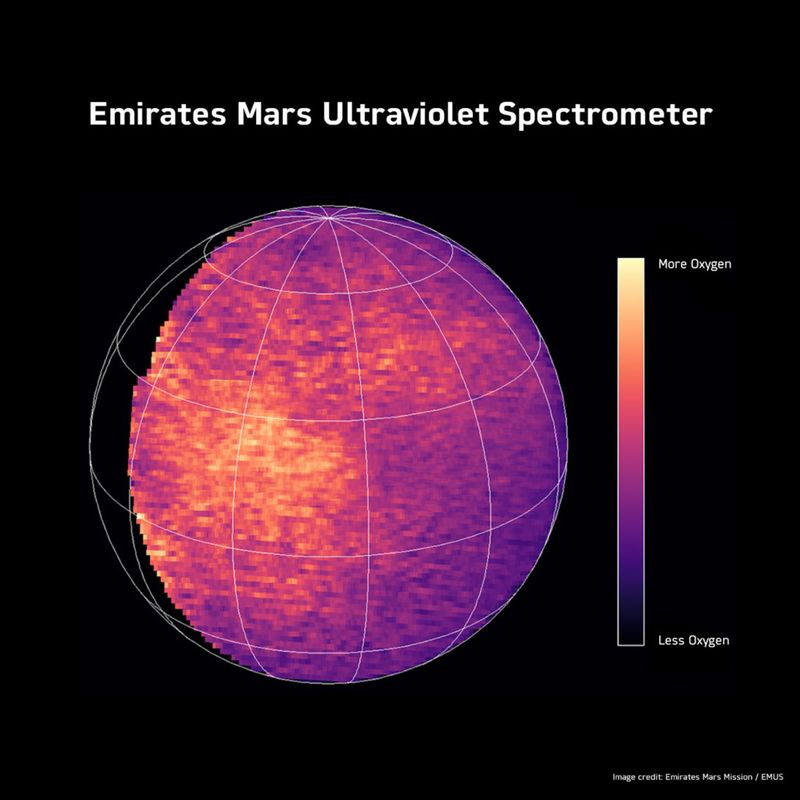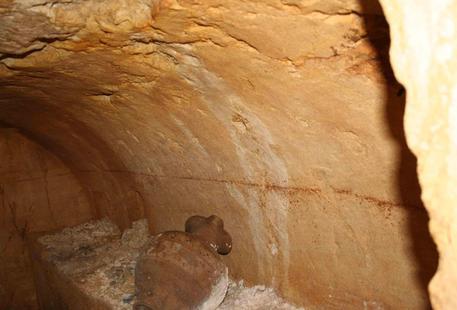From photographing rare aurora to studying atomic oxygen in the atmosphere – the Emirati mission has had a busy year
:quality(70):focal(-5x-5:5x5)/cloudfront-eu-central-1.images.arcpublishing.com/thenational/CMPYOVH22CBGRKOTHXZSM6UTT4.jpg)
:quality(70)/cloudfront-eu-central-1.images.arcpublishing.com/thenational/WE5Q5EIJR3EJZ2TQJ5YFREIQLU.jpg)
This image was taken by the infrared spectrometer, another instrument on the Hope probe, from an altitude of about 15,000 kilometres. The image shows the surface temperature (left), centred on the Tharsis region of Mars. Dawn can be seen towards the right side. The low surface temperatures observed are due to the dusty nature of the Martian surface. An elevated nighttime atmospheric temperature at 25 km altitude (right) is also observed over the Tharsis region. (Courtesy: Emirates Mars Mission)
Jul 20, 2021
The UAE is marking one year since it launched the Arab world’s first mission to Mars.
On July 20, 2020, the Hope probe was carried to space aboard the H-IIA rocket from Tanegashima Space Centre in Japan.
After a solo journey of 493 million kilometres in seven months, the spacecraft successfully entered the orbit of Mars on February 9.
Since then, fascinating images of the planet and scientific readings of the Martian atmosphere have been made public.
“We’ve had quite a lot of ‘wiggle room’ in addition to our planned parameters, and our confidence in our spacecraft has gone from strength to strength,” said Omran Sharaf, project director of the mission at the Mohammed bin Rashid Space Centre.
“We were able to cut the number of trajectory correction manoeuvres, perform additional observations during our flight to Mars and now have added a whole area of scientific study to the mission that I can only describe as a bonus. It has been a very busy year indeed for Hope.”
The spacecraft will spend two years capturing data that scientists can use to better understand the atmospheric conditions on Mars and how the Red Planet dried out.
The National highlights some milestones since the launch of the UAE’s mission to Mars.
First image of Mars taken by an Arab mission
On February 14, the first image of Mars taken by Hope was released.
It marked the spacecraft’s arrival at the Red Planet.
:quality(70)/cloudfront-eu-central-1.images.arcpublishing.com/thenational/YZWUZMXPJTE46DTRIMF7DFMRYI.jpg)
The first image of Mars taken by the UAE's Hope probe. Courtesy Emirates Mars Mission
Sheikh Mohamed bin Zayed, Crown Prince of Abu Dhabi and Deputy Supreme Commander of the Armed Forces, shared the image on social media, describing its transmission as "a defining moment in our history".
He said that the image "marks the UAE joining advanced nations involved in space exploration. We hope this mission will lead to new discoveries about Mars which will benefit humanity."
The photo showed the solar system’s largest volcano, Olympus Mons, at sunrise.
Hope’s Emirates exploration imager – a high-resolution camera – took the image 24,700 kilometres above the Martian surface.
Scientific readings of the atmosphere
The mission began capturing scientific data before its science phase began.
Hope is using an infrared spectrometer, exploration imager and ultraviolet spectrometer to record data from the planet’s atmosphere.
On May 24, all three instruments observed the planet to provide a snapshot of the Arabia Terra region.
The infrared spectrometer mapped the temperature of the atmosphere and how it warmed up over the course of the morning.
:quality(70)/cloudfront-eu-central-1.images.arcpublishing.com/thenational/GTTI3IRULZAYBPSAN4QYORFHAA.jfif)
The Hope probe's ultraviolet spectrometer captured the distribution of atomic oxygen in the atmosphere of Mars. Courtesy Emirates Mars Mission
The exploration imager captured many photos. One in ultraviolet showed bright dust on the planet's surface, and an image captured in red band highlighted the thin water-ice clouds.
The ultraviolet spectrometer captured scientific readings that showed distribution of oxygen atoms in the planet’s upper atmosphere.
Only Nasa’s Viking and Mariner missions in the 1970s, and more recently the Sofia and Maven missions, have captured presence of atomic oxygen in Martian atmosphere before.
By studying distribution of oxygen, scientists can learn more about atmospheric erosion and how other gases escape the planet.
Dancing lights on Mars
On June 30, rare images of the discrete aurora on Mars’ night side atmosphere taken by the Hope probe were released.
The data would help scientists understand the interaction of the atmosphere with solar particles.
“Mars’ aurorae are an area of intense interest to the global scientific community, and their study has tremendous potential to challenge, expand and deepen our understanding of Mars’ atmosphere and its interaction with the planet and with solar energies,” said Hessa Al Matroushi, the mission’s science lead.
“We were hopeful that Emus [ultraviolet spectrometer] could make a contribution in this area but we now know with absolute certainty that contribution is going to be ground-breaking.”
Studying space dust
On the Hope probe's way to Mars, an additional scientific objective was assigned to the mission.
The ultraviolet spectrometer was activated to cross-calibrate with the Phebus spectrometer aboard the European Space Agency’s BepiColombo spacecraft, which was on its way to Mercury.
Hope captured data on interplanetary dust, which is believed to have played an important role in the formation of the solar system 4.6 billion years ago.
The findings will be combined with data collected by BepiColombo.
What's next?
All data observed so far will be released to the public in October.
Researchers will be able to use the data to study the atmospheric dynamics of Mars and understand why gases are escaping from its atmosphere, making it impossible for the planet to host life.
The spacecraft will continue observing the planet's upper and lower atmosphere until 2023.
Mr Sharaf previously told The National that this mission has paved the way for more deep space exploration missions by the UAE.
“This platform is definitely the foundation for UAE’s future outer space exploration missions that will be developed,” he said.
“The main core of the spacecraft, system architecture, design and knowledge are some things that can definitely be re-used. Hopefully, there will be some innovation added to it but, basically, this is the foundation.





















